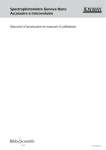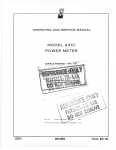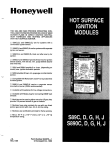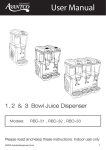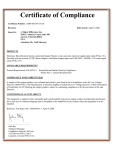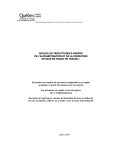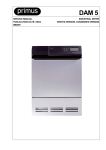Download LAHK-1 Service Manual
Transcript
MANUFACTURED FOR: MITSUBISHI ELECTRIC US, INC. TECHNICAL & SERVICE MANUAL Model 2015 2015 LAHK-1 Low Ambient Hood TECHNICAL & SERVICE MANUAL for use with: CITY MULTI® PUHY-P-T/Y(S)K/LMU, PURY-P-T/Y(S)K/LMU, andLAHK-1 PURY-HP-T/Y(S)KMU Series Hood Model Low Ambient Outdoor Units 4000292 4000292 Contents 1. Control Box Component Identification.....................................2 2. Operating Sequence...............................................................3 3. Damper Blade Adjustment.......................................................5 4. Damper Actuator Manual Override..........................................8 5. Parts List.................................................................................9 6. Wiring Diagram......................................................................10 1.LAHK-1 Control Control Box Component Identification Box Component Identification Operating Sequence Outdoor Unit in Cooling Mode The LAHK-1 low ambient hood is designed to reduce the airflow through the outdoor units as the ambient temperature drops. This maintains the head pressure at a level that will allow the system to perform at 100% o capacity down to -10 F outdoor temperature. A thermistor mounted on the side of the unit senses the outdoor temperature. As the outdoor temperature drops, the resistance of the thermistor increases. The thermistor is connected to the specially designed circuit board and the resistance value from the thermistor is converted to a DC voltage output within the circuit board. This DC voltage output drives the damper actuator to a predetermined position based on the outdoor temperature. The inverter driven fan motor will adjust the discharge pressure based on system capacity demand. The motor will speed up and force more air through the damper if there is a higher system capacity demand, or slow down if system capacity demand decreases. Specifications are subject to change without notice. Outdoor Unit in Heating Mode Heating mode requires the damper be in the fully open position to allow full airflow and maximum heating capacity. Heating mode automatically deactivates the kit through an interlock relay. The coil for this relay is tied into the reversing valve connection on the outdoor unit. When the unit switches to heating mode, the reversing valve is energized. This in-turn energizes the interlock relay. When the relay is energized, the normally closed contact opens. By opening this contact, the power to the transformer and control board is interrupted, this allows the damper to spring to the full open position. Outdoor Unit in Defrost Mode If the outdoor unit will be running in heating mode, a defrost period is inevitable. During defrost the low ambient controls see this as the unit operating in cooling mode. If the outdoor temperature is below 50 F, the damper will close to a position equal to that required during the cooling cycle. Once the unit comes back out of defrost and into heating mode, the damper will again spring wide open for full airflow. Operation Test © 2015 Mitsubishi Electric US, Inc. Outdoor unit must be in cooling mode 2 2. Operating Sequence Outdoor Unit in Cooling Mode The LAHK-1 low ambient hood is designed to reduce the airflow through the outdoor units as the ambient temperature drops. This maintains the head pressure at a level that will allow the system to perform at 100% capacity down to -10oF outdoor temperature. A thermistor mounted on the side of the unit senses the outdoor temperature. As the outdoor temperature drops, the resistance of the thermistor increases. The thermistor is connected to the specially designed circuit board and the resistance value from the thermistor is converted to a DC voltage output within the circuit board. This DC voltage output drives the damper actuator to a predetermined position based on the outdoor temperature. The inverter driven fan motor will adjust the discharge pressure based on system capacity demand. The motor will speed up and force more air through the damper if there is a higher system hoods and damper controls are iftested the factory capacity demand, or slow down system at capacity demand decreases. ore shipping. To perform an operational test once installation has been completed, follow the steps Outdoor Unit in Heating Mode ow. Heating mode requires the damper be in the fully open position to allow full airflow and maximum heating capacity. mode automatically deactivates the kit through erationHeating testing when the outdoor ambient is an interlock relay. The coil for this relay is tied into the reversing valve connection OVE 50°F on the outdoor unit. When the unit switches to heating mode, the reversing valve is energized. This in-turn energizes the interlock relay. the relay is energized, normally closed contact 1. Turn onWhen power to the outdoorthe unit. opens. By opening this contact, to the transformer 2. Make sure the outdoor unitthe is power in cooling mode. and control board is interrupted, this allows the damper to spring to the 3. Locate the outdoor temperature sensing full open position. thermistor at the end of the short conduit Outdoor Unit in Defrost coming out the side ofMode the control panel, it can the outdoor unit will be running in heating mode, a defrost period beIfisseen inside the plastic shield. inevitable. During defrost the low ambient controls see this as the dusting sprayer, invert the is below 4. Using an aerosol unit operating in cooling mode. If the outdoor temperature can thermistor withequal veryto short 50and F, thespray damperthe will close to a position that required during the cooling cycle. Once the unit comes backDo outNot of defrost and into bursts of the cold liquid. Caution! heating mode, the damper will again spring wide open for full airflow. overspray the thermistor as it could be damaged. It may take 10 – 20 seconds for Operation Test Outdoor unit must be in cooling mode the internal thermistor temperature to drop. All hoods and damper controls are at thethe factory before The damper will start to movetested toward shipping. To perform an operational test once the installation has closed position follow after the thesteps thermistor drops been completed, below. below 50°F Operation testing when the outdoor ambient is ABOVE 5. Once the thermistor warms above 50°F, it will 50° F move back to the full open position indicating 1. Turn on power to the outdoor unit. the2.lowMake ambient is working designed. sure thekit outdoor unit is in as cooling mode. 3. Locate the outdoor temperature sensing thermistor at the end of the short conduit coming out the side of the control panel, it can eration testing when the outdoor ambient is be seen inside the plastic shield. LOW 50°F 4. Using an aerosol dusting sprayer, invert the can and spray the thermistor with very short bursts of the cold liquid. Caution! Do Not overspray the thermistor as it could be 1. Turn on powerIttomay thetake outdoor damaged. 10 – 20 unit. seconds for the internal 2. Make thermistor sure the outdoor unit is in cooling mode. temperature to drop. The damper start to move toward the closed position after 3. The damper willwill move toward the closed the thermistor drops below 50°F position to a predetermined position based on 5. Once the thermistor warms above 50°F, it will move back to the the outdoor temperature, indicating full openambient position indicating the low ambient kit is working as the lowdesigned. ambient kit is working as designed. testing when the outdoor ambient is BELOW 50° F either ofOperation these tests work. Proceed with the mponent1.troubleshooting instructions. Turn on power to the outdoor unit. 2. 3. Make sure the outdoor unit is in cooling mode. The damper will move toward the closed position to a mponentpredetermined Troubleshooting position based on the outdoor ambient temperature, indicating the low ambient kit is working as ermistor e thermistordesigned. is a 10,000 Ω, NTC Type. e circuit ©board has aElectric blinking 2015 Mitsubishi US, Inc.indicator light built in to erence what the thermistor is sensing. The chart ow shows what the blinking light sequence means. position to a predetermined position based on the outdoor ambient temperature, indicating the low ambient kit is working as designed. If neither of these tests work. Proceed with the troubleshooting instructions. Ifcomponent neither of these tests work. Proceed with the component troubleshooting instructions. Component Troubleshooting Component Troubleshooting Thermistor Thermistor Thethermistor thermistor a 10,000 Ω,Type. NTC Type. The is a is 10,000 Ω, NTC Thecircuit circuit board has a blinking indicator built in to The board has a blinking indicator light built light in to reference what the thermistor is sensing. The chart below shows the reference what the thermistor is sensing. Thewhat chart blinking light sequence means. below shows what the blinking light sequence means. Blink(s) 1 2 3 chart, the thermistor Constant ON Thermistor Temperature Above 50F 50F to 20F Below 20F needs to beisreplaced. If it’s Thermistor open or shorted suspected that the thermistor is operating inaccurately, check in the following instructions. If thethe lighttolerance is on constantly, the thermistor is open or If the light is on constantly, the thermistor is open or shorted and Disconnect the thermistor from the control board. shorted and needs to be replaced. If the blinking light needs to be replaced. If the blinking light sequence doesn’t fall within Measure the resistance across the two leads. Measure sequence doesn’t fall within the range given in the the range given in the chart, the thermistor needs to be replaced. If it’s suspected that the is operating inaccurately,on check the temperature of thermistor the thermistor. (Accuracy thethe December 2013 tolerance in the following instructions. © 2013 Mitsubishi Elect temperature reading is important to prevent a good Disconnect the thermistor from the control board. Measure the thermistor from the being replaced). resistance across two leads. Measure the temperature of the Compare ohm on reading with the temperature thermistor. the (Accuracy the temperature reading is importanton to the prevent a goodBased thermistor replaced).temperature the chart below. onfrom thebeing thermistor Compare the ohm reading the temperature thenumber chart below. ohm reading should bewith within 1-2% of on the Based on the thermistor temperature the ohm reading should be shown below. If number not, and thebelow. thermistor connections within 1-2% of the shown If not, and the thermistor are not corroded, the thermistor should bebereplaced. connections are not corroded, the thermistor should replaced. o F 86 84 82 81 79 77 75 73 72 70 68 66 64 63 61 o Ohms 8,056 8,448 8,862 9,077 9,526 10,000 10,501 11,031 11,307 11,884 12,493 13,139 13,822 14,179 14,924 F 59 57 55 54 52 50 48 46 45 43 41 39 37 36 34 Ohms 15,714 16,551 17,438 17,902 18,873 19,903 20,997 22,159 22,767 24,040 25,394 26,835 28,368 29,171 30,856 o F 32 30 28 27 26 23 21 19 18 16 14 12 10 9 7 o Ohms 32,650 34,562 36,601 37,671 38,776 42,315 44,875 47,610 49,047 52,069 55,301 58,759 62,460 64,408 68,510 F 5 3 1 0 -2 -4 -6 -8 -9 -11 -13 -15 -17 -18 -20 Ohms 72,906 77,620 82,676 85,340 90,962 96,999 103,486 110,460 114,141 121,921 130,295 139,313 149,030 154,169 165,048 Circuit Board Confirm the thermistor is operating properly before troubleshooting the circuit board. Make sure the control board has 24 Volts AC when measured at the 24 VAC and the com terminals. If not, find the cause of voltage failure. The circuit board is designed to convert the thermistor ohm input to a 2 - 9.16 VDC output to control the position of the damper actuator. Above 2 VDC output the actuator will start to move the damper toward the closed position. At 9.16 VDC, the actuator will have moved 85 degrees and the damper will be approximately 95% closed. The damper should never be 100% closed. The chart below includes the various damper angles based on the different outdoor temperatures. Measure the DC voltage output on the circuit board at com (-) and the out (+) terminals. If the Specifications are subject to change without notice. output doesn’t match the thermistor input ohms as shown below, replace the circuit board. Outdoor Temperature o Thermistor Ohms Control board DC volts output Damper Angle o 3 measured at the 24 VAC and the com terminals. If not, nd the cause of voltage failure. The circuit board is designed to convert the thermistor hm input to a 2 - 9.16 VDC output to control the Circuit Board Interlock Relay osition of the damper actuator. 2 VDC output Confirm the thermistor is operating properlyAbove before troubleshooting The interlock relay uses a normally closed contact to allow power the circuit board. to flow to the transformer energizing the low ambient kit control he actuator will start to move the damper toward the Make sure the control board has 24 Volts AC when measured at circuitry. Any time the outdoor unit is in cooling mode, this contact have will losedThe position. 9.16 VDC, theAC. actuator the 24 VAC and At theiscom terminals. If not, find the ofwill voltage be in closed. When the outdoor unit reversing valves energizes Damper Actuator transformer 208/230 – 24volt Forcause proper failure. (switches to heating mode) the of the relay is energized, opening moved 85 degrees the damper willdiagram be Before trouble shooting thecoildamper motor, verify the connections to the and outdoor unit, the following The circuit board is designed to convert the thermistor ohm input this contact. This in-turn de-energizes the transformer, disconnecting two factory switches are in the position shown below. and instructions should be referred to. pproximately 95% closed. damper should never to a 2 - 9.16 VDC output to control The the position of the damper power to the low ambient kit control circuitry. This allows the damper actuator. Above 2 VDC output the actuator will includes start to move the to spring return to the full open position during heating mode. Damper Actuator be 100% closed. The chart below the various damper toward the closed position. At 9.16 VDC, the actuator will To check, make sure the contact is closed when the outdoor unit is in black Black and amper angles onthethe different outdoor95% (1)the contact Commonis open when the have moved 85based degrees and damper will be approximately cooling mode (coil de-energized) closed. The damper should never be 100% closed. The chart outdoor unit is in thered heating mode (coil energized). emperatures. Measure the DC voltage output on the Red (2) + Hot below includes the various damper angles based on the different ircuit boardtemperatures. at iscom (-) –and out (+) terminals. the Actuator outdoor Measure thethe DC voltage on the circuit If Damper Damper Actuatorwhite White The transformer 208/230 24volt AC. For output proper (3) 2-10VDC board at com (-) and the outunit, (+) terminals. If the output doesn’t match Before Before trouble trouble shooting thethe damper motor,motor, verify the two factory connections to the outdoor the following diagram shooting damper verify the utputthedoesn’t match the thermistor input ohms as thermistor input ohms as shown below, replace the circuit board. switches are in the positionOrange shown below. (5) and instructions should be referred to. two factory switches are in the position shown below. hown below, replace the circuit board. Outdoor Temperature o Thermistor Ohms N/A Control board DC volts output 2.00 Damper Angle Y=0 Damper Y=0 Actuator black o Above 52 F 0 full open 52 18,873 2.00 0o o 50 19,903 3.25 15 o 45 4.50 30 The low ambient kit is22,767 designed to function with both 40 26,104 5.80 45o 208/230 volt and also 460 volt outdoor units. 35 30,000 7.04 60o On 208 volt units the 34,562 CNAC2 connector will provide o 30 7.90 70 red white Black (1) Common Red Hot Factory (2) switch +positions White (3) 2-10VDC Make sure the motor has 24 volts on the (1) Common Orange If (5) and (2) +Hot connections. not, find the cause of the voltage failure and correct. Y=0 Y=0 The damper actuator receives a DC voltage signal from the circuit board. This voltage can be measured between (1) Common and (3) 2-10VDC connections. The damper actuatorFactory has an angle indicator where it switch positions clamps onto the damper shaft linkage. Damper Actuator Compare themotor DCshooting voltage supply to damper anglethe Before the damper verify Make sure trouble the has 24 volts onthe themotor, (1) Common Make sure the motor has 24 volts on the (1) Common and (2) +Hot indicator position in the chart below. The angle should two switches areIf in thefind position shown and (2) factory +HotIfconnections. not, the cause of below. the connections. not, cause of the voltage and correct. of find the the chart shown below. Iffailure not, check to be within 2% voltage failure and correct. The damper receives a DC voltage signal from the circuit Damper Actuator make sureactuator the damper started off in the correct The damper actuator receives a DC voltage signal and (3) board. This voltage can be measured between (1) Common black position. 0 Degrees (1)can Common 2-10VDC connections. from the circuit board. ThisBlack voltage be measured The damper has angle where it clamps onto the red an between (1) actuator Common and (3) indicator 2-10VDC connections. (2) + Hot IMPORTANT! damper shaft actuator linkage. has Red The damper an angle indicator whereshaft it It’s possible during theangle damper Compare the DCthat voltage supplyshipping, to the damper indicator white White linkage. (3) 2-10VDC clamps onto the damper shaft may have in the shaft clamp position in themoved chart below. Theactuator angle should be within 2% of the Compare thebelow. DC voltage supply to the damper angle chart shown Ifpower not, check to make sure the damper started assembly. With off, make sure the damper is off Orange (5) indicator position in the chart below. The angle should ininthe correct position. 0 Degrees the full open position. 0 degrees If necessary, beloosen within 2% the chart below. If not, check Y=0 the Y=0 the of shaft clampshown on actuator, move theto IMPORTANT! make sure the damper started off in the correct damper to the 100% open position, and re-clamp It’s possible that during shipping, the damper shaft may have position. 0 Degrees tightly. moved in the actuator shaft clamp assembly. See Section 3. 208 volts25to the control transformer. 8.75 39,917 80o On 230 volt CNAC2 connector 20 units the 46,220 9.16 will provide 85o 230 volts transformer. 9.16 Belowto 20othe F controlN/A 85o The 460 volt units include a transformer that reduces Transformer the outdoor unit internal voltage to 230 volts. Because Transformer of this, on thekit 460 volt units CNAC2 connector will to is 208/230 –the AC. Forconnections proper TheThe low ambient designed to24volt function with both Thetransformer transformer is is 208/230 – 24volt AC. For proper also provide 230 volts to the control transformer. connections toalso the outdoor unit, the following diagram the outdoor unit, the following and instructions should be 208/230 volt and 460 voltdiagram outdoor units. Once the propershould connection is confirmed, measure referred instructions beconnector referred to. On and 208 volt to. units the CNAC2 will provide voltage on the primary side of the transformer. It 208 volts to the control transformer. should be 208 or 230 +- 10% depending on the supply 230 volt units the CNAC2 connector will provide c On US, Inc. voltage at the outdoor unit. If there is no voltage on the 230 volts to the control transformer. primary side of the transformer check the fuse that is The located 460 voltinunits include a transformer that reduces the fuse holder inside the outdoor unit. See the outdoor unit internal voltage to 230 volts. Because wiring diagram for fuse location. Once power has been of this, on the 460 volt units the connector will confirmed at the primary sideCNAC2 of the transformer, check also the provide 230 volts to the control secondary/low voltage side oftransformer. the transformer it Once the proper connection is should be approximately 27confirmed, volts. If no measure voltage is voltage on the primary side of the present, replace transformer. transformer. It should be 208 or 230 +- 10% depending on the supply voltage at the Relay outdoor unit. If there is no voltage on the Interlock primary side of the transformer check the fusecontact that is to The interlock relay uses a normally closed Damper Blade Adjustment. Factory switch positions located in power the fuse holder inside the outdoor unit. See IMPORTANT! allow to flow to the transformer energizing the If the damper actuator angle doesn’t match within 2%, The low ambient kit location. is designed to function with both wiring for Once power has been It’s possible that during shipping, damper lowdiagram ambient kitfuse control circuitry. Any time the outdoor the corresponding boardthe voltage Ifwith the damper actuator anglecontrol doesn’t match within 2%,supplied withshaft the 208/230 volt and alsoside 460 volt outdoor units. Make sure the motor has 24actuator volts onas the (1)bebelow, Common corresponding control board voltage supplied shown the confirmed at the primary of the transformer, check may have moved in the actuator shaft clamp contact will be in closed. unit is in cooling mode, this as shown below, the damper should The low ambient kit is designed to function with both 208/230 volt 208the volt units the will provide and (2) +Hot connections. If not, findthe the damper cause ofisthe damper actuator be replaced. the On secondary/low side ofconnector the transformer it assembly. Withshould power off, make sure When outdoor unitCNAC2 reversing valves energizes replaced. and also 460 voltvoltage outdoor units. 208 volts to the control voltage failureposition. and correct. should approximately 27transformer. volts. nowill voltage is208isvolts to the in the full open 0 degrees If necessary, (switches tounits heating mode) the Ifcoil of the relay Onbe 208 volt the CNAC2 connector provide On 230 volt units the CNAC2 connector will provide The damper actuator receives a DC voltage signal control transformer. present, replace transformer. energized, opening this contact. This in-turn deloosenOutdoor the shaft clamp on theControl actuator, moveDamper the Thermistor board On 230 volt units the CNAC2 connector will provide 230 volts to the 230 volts to the control transformer. from the circuit board. This voltage can be measured Temperature Ohms DC volts output Angle energizes the transformer, disconnecting power to the damper to the 100% open position, and re-clamp o o control transformer. N/A 2.00 Above 52 F(1) Common 0 full open The 460 volt kit units include a transformer thatthe reduces between and (3) 2-10VDC connections. low ambient control circuitry. This allows damper Interlock Relay tightly. The 460 volt units include a transformer that reduces the outdoor 52 18,873has an angle 2.00 indicator where 0o outdoor unituses internal voltage to 230 contact volts. Because The damper actuator it to spring return to theafull open position during heating Thethe interlock relay normally closed o unit internal voltage to 230 volts. Because of this, on theto460 volt 50 19,903 3.25 15 of this, on the 460 volt units the CNAC2 connector will clamps onto the damper shaft linkage. mode. allowunits power to flow connector to the transformer energizing If the damper actuator angle doesn’t4.50 match within 2%, the CNAC2 will also provide 230 volts the to the control 45 30o provide 230 sure volts to the control transformer. the DC 22,767 voltage tovoltage the damper angle To check, the contact is closed when the low also ambient kitmake control circuitry. Any time the outdoor withCompare the corresponding controlsupply board supplied o transformer. 40 26,104 5.80 45 Once the proper connection is confirmed, measure indicator position in the chart below. The angle should outdoor unit is in cooling mode (coil de-energized) and Once the proper connection is confirmed, measure voltage on the unit is in cooling mode, this contact will be in closed. as shown35below, the 30,000 damper actuator 7.04should be 60o primary sidethe of the transformer. should be 208 is or in 230the voltage on primary side the transformer. It+- 10% o the contact is open when theItofoutdoor unit be within 2% of the chart shown7.90 below. If not, 70 check to 30 When the outdoor unit reversing valves energizes 34,562 replaced. depending on the voltage atdepending the unit. If there is no heating mode (coil energized). should 208 orsupply 230 +10% on is the supply make25sure the damper in the correct 39,917 started off 8.75 80o (switches tobe heating mode) the coil of outdoor the relay voltage on the primary side of the transformer the fuse that is 20 46,220 voltage at the outdoor unit. If This there is nocheck voltage on the position. 85o energized, opening this contact. in-turn deOutdoor 0 Degrees Thermistor Control9.16 board Damper located in the fuse holder inside the outdoor unit. See wiring diagram o N/A 9.16 Below 20 F 85o primarythe side of the transformer check power the fuse that is Temperature Ohms DC volts output Angle energizes transformer, disconnecting for fuse location. Once power has been confirmed at to thethe primary o o N/A 2.00 inkitthe fuse holder the outdoor unit.side Seeof IMPORTANT! Above 52 F 0 full open low located ambient control circuitry. allows the damper side of the transformer, check inside theThis secondary/low voltage 18,873 2.00 0o wiring diagram for fusebe location. Once been is It’s52possible that during shipping, the damper shaft the transformer should approximately 27power volts.heating If has no voltage to spring return to itthe full open position during December 2013 50 19,903 3.25 15 confirmed at thetransformer. primary side of the transformer, check may have moved in the actuator shaft clampo present, replace 4 mode. © 2013 Mitsubishi Electricassembly. US, 45 Inc. 4.50 sure the damper 30o the secondary/low voltage side the transformer With22,767 power off, make is To check, make sure the contact is of closed when the it o 40 5.80 45 US, Inc. Specifications are subject to change without notice. © 2015 Mitsubishi Electric should 27 volts. If no voltage and is in the full open26,104 position. 0 degrees If necessary, outdoor unitbeisapproximately in cooling mode (coil de-energized) o 35 30,000 7.04 60 transformer. loosen the shaft clamp on the actuator, move the the present, contact isreplace open when the outdoor unit is in the 30 34,562 7.90 70o damper to the 39,917 100% open position, and re-clamp o heating 4mode (coil energized). 25 8.75 80 Interlock Relay tightly. 20 46,220 9.16 85o 3 100%. The damper should never be 100% closed during operation. When working properly the damperBlade will be approximately 95% closed at 20 degrees and below. The following 3. Damper Adjustment procedure will allow proper adjustment. IMPORTANT! The Belimo within LAHK control box has to a built in The Belimo damper motor within the LAHK control boxdamper has amotor built in the mechanical stop It’s possible that during shipping, the damper shaft may have mechanical stop to adjust the maximum angle of rotation. This must moved in the actuator shaft clamp assembly. In some cases due must be adjusted to 85 degrees damper blade verified or adjust the maximum angle of rotation. This be adjusted to and 85 the degrees andposition the damper to manufacturing tolerances the LAHK blades could close 100%. re-set to the proper position (1/4” open) to ensure the unit functions The damperposition should never be 100% or closed during properly. blade verified re-set tooperation. the proper position (1/4” open) to ensure the unit When working properly the damper will be approximately 95% closed at 20° and properly. below. The following procedure will allow proper functions adjustment. Belimo motor angle indicating Belimo motor angle indicating scale shown below. scale shown below. The factory setting for the mechanical The factory setting for the mechanical stop stop isisshown below shown below at 95 at 95. IMPORTANT! ENSURE POWER IS OFF BEFORE STARTING!! Basic Service Overview 1. Set damper motor stop to 85 degrees. 2. Loosen “U” bolts on damper shaft. 3. Crank motor against 85° stop then lock into position. 4. Set damper to approx. ¼” open. (Use damper crank handle as spacer.) 5. Re-Tighten “U” bolts on damper shaft. 6. Release motor by slightly cranking with handle. Check operation manually. 7. The goal is to have ¼” opening on damper assembly in the 85 degree position. IMPORTANT! ENSURE POWER IS OFF BEFORE STARTING!! Basic Service Overview 1.) Set damper motor stop to 85 degrees. 2.) Loosen “U” bolts on damper shaft 3.) Crank motor against 85 degree stop then lock into position 4.) Set damper to approx. ¼” open. (Use damper crank handle as spacer.) 5.) Re-Tighten “U” bolts on damper shaft 6.) Release motor by slightly cranking with handle. Check operation manually 7.) The goal is to have ¼” opening on damper assembly in the 85 degree position. © 2015 Mitsubishi Electric US, Inc. Specifications are subject to change without notice. 5 Slide STEP STEPBYBYSTEP STEPINSTRUCTIONS INSTRUCTIONS Slidethe themechanical mechanicalstop stoptoto8585(halfway (halfway between 8 and 9) and tighten the screw, STEP BY STEP INSTRUCTIONS STEP BY STEP INSTRUCTIONS Loosen the Philips head screw for the 11 Loosen the Philips head screw for the 22 Slide between 8 and 9) and tighten the screw, Slide the the mechanical mechanical stop stop toto 8585 (halfway (halfway making sure the locating teeth on the stop mechanical stop. making sure the locating teeth on the stop Slide the mechanical stop to 85 (halfway mechanical stop. between between 8 and 8 and 9) 9) and and tighten tighten the the screw, screw, Slide the mechanical stop to 85 (halfway Loosen Loosen the the Philips Philips head head screw screw for for the the STEP BY STEP INSTRUCTIONS: 2 2 are engaged into the actuator motor teeth. 11 are engaged into the actuator motor teeth. between and and tighten the screw, making sure sure the the locating locating teeth teeth on on the the stop stop between 8 8and 9)9) and tighten the screw, Loosen the Philips head screwfor for the 22. mechanical mechanical stop. stop. 2 making the Philips screw the 1 Loosen 1. 1Loosen the Philips head screw head for the mechanical stop. Slide the mechanical stop to 85 (halfway between 8 and 9) and making sure the locating teeth onthe the stop are are engaged engaged into into the the actuator actuator motor motor teeth. teeth. making sure the locating teeth on tighten the screw, making sure the locating teeth onstop the stop are engaged into the actuator motor teeth. areengaged engagedinto intothe theactuator actuatormotor motorteeth. teeth. are mechanicalstop. stop. mechanical Loosen Loosenthe the(2)(2)nuts nutsononthe the damper shaft “U” clamp damper shaft “U”on clamp Loosen Loosen the the (2) nuts nuts on the the 1.(2) 3 3 3. Loosen the (2)damper nuts on the damper shaft “U” clamp. Loosen the nuts onthe the damper shaft shaft “U” “U” clamp clamp Loosen the (2)(2) nuts on 33 dampershaft shaft“U” “U”clamp clamp damper 33 Lock Lockthe themotor motorininthe the 55 5. Lock the motor in85 the degree 85 degreeposition. position. 85the degree position. Lock Lock the motor motor inin the the 55 Lock themotor motor the 85 85 degree degree position. position. Lock the ininthe 55 degreeposition. position. 8585degree Specifications are subject to change without notice. 6 Using Usingthe thecrank crankhandle handleturn turnthe themotor motor until the indicator snugs 44 counterclockwise counterclockwise until the indicator snugs Using Using the the crank crank handle handle turn turn the the motor motor against the stop at 85 degrees. against theuntil stop atthe 85 degrees. Using thecrank crank handle turn themotor motor counterclockwise until the indicator indicator snugs snugs Using the handle turn the 4 4 counterclockwise 4. Using the crank handle turn the motor counterclockwise until the counterclockwise until the indicator snugs against against the the stop stop atthe at 85 85 degrees. degrees. until indicator snugs 44 counterclockwise indicator snugs against the stop at 85 degrees. againstthe thestop stopatat8585degrees. degrees. against 66 6. 66 66 Close Closethe theblades bladesbybyhand handand andinsert insert Crank handle under damper blade near Crank handle under damper blade near Close Close the the blades byby hand hand and and insert insert Close the blades byblades hand and insert Crank handle under the screws as shown to ensure it is open damper blade near the screws as shown to ensure it is open the screws as shown tohand ensure itinsert is open Close the blades byhand and Crank Crank handle handle under under damper damper blade blade near near Close the blades by and insert approximately ¼ inch at 85 degrees. approximately ¼¼inch atat8585degrees approximately inch Crank handle under damper blade near the the screws screws asas shown shown to to ensure ensure itdegrees it is is open open Crank handle under damper blade near the screwsasasshown shown toensure itisisopen open approximately approximately ¼¼ inch inch atensure at 8585 degrees the screws to itdegrees approximately¼¼inch inchatat8585degrees degrees approximately © 2015 Mitsubishi Electric US, Inc. on the handle damper shaft “U” clamp. re-tighten the (2) nuts 7 on the damper shaft “U” clamp. 7 7. 8 8 8. Holding the blades against the handle re-tighten the (2) nuts Holding againstshaft the handle on the theblades damper “U”re-tighten clamp.the (2) nuts on the damper shaft “U” clamp. Ensure end of shaft is flush to Ensure end of shaft is flush edge of clamp black surface as to Ensure end shaft isblack flush tosurface as shown. edge ofofclamp edgeend of clamp as black surface as shown. Ensure of shaft isblack flush tosurface edge of clamp shown. shown. Ensure end of shaft is flush to edge of clamp black surface as shown. Slightly crank the handle to release Slightly crank the handle to release the motor. The damper will return Slightly crank the handle release thewill motor. The damper will the motor. Thetodamper return to the open position. return to the open position. to the the open position. crank handle release Slightly crank the handle to to release 8Slightly the motor. TheThe damper return the motor. damper will will return to the openposition. position. to the open Review and Manual Test To ensure the LAHK unit is functioning as designed. Crank the Belimo motor back to the 85 degree position and visually check that the damper does not close completely. Your goal is approximately ¼” opening between the blades at the 85 degree position. Review and Manual Test Review Test To ensureand the Manual LAHK unit is functioning as designed. Crank the Belimo motor back to 85 degree position and checkas that the damper does notBelimo close completely. Tothe ensure the LAHK unit is visually functioning designed. Crank the motor back to Review and Manual Test Your goal is approximately ¼” opening between the blades at the 85 degree position. the 85 degree position and visually check that the damper does not close completely. To ensure the LAHK unit is functioning as designed. Crank the Belimo motor back to Your goal is approximately ¼” opening between the blades at the 85 degree position. the 85 degree position and visually check that the damper does not close completely. Your goal is approximately ¼” opening between the blades at the 85 degree position. Review and Manual Test To ensure the LAHK unit is functioning as designed. Crank the Belimo motor back to the 85 degree position and visually check that the damper does not close completely. Your goal is approximately ¼” opening between the blades at the 85 degree position. © 2015 Mitsubishi Electric US, Inc. Specifications are subject to change without notice. 7 Damper Actuator Manual Override Damper Actuator Manual Override IMPORTANT! Never manually override the damper 4. Damper Manual Override position if Never the Actuator outdoor unit could switch to heating IMPORTANT! manually override the damper mode during the override period. Heating mode position if the outdoor unit could switch to heating IMPORTANT! Never manually override the damper position requires the damper to be fully open for full mode during the override period. Heating mode ifcapacity. the outdoor unit could switch to heating mode during the requires the damper to be fully open for full Useprocedure. the following diagrams and instructions for this procedure. override period. Heating mode requires the damper to be fully capacity. open for full capacity. It may be desirable to manually override the damper position and lockto into position until repairs can beand It may desirable override the damper position It may bebedesirable toitmanually manually override the damper completed. If so, select an average temperature typical lock it into position until repairs can be completed. If so, select an position and lock it into position until repairs can be average temperature typical for theduring outsidethe environment during the for the outside environment override period, completed. If so, select an average temperature typical override period, and then use that average temperature to find the to find the andoutside then use that average temperature for the environment during the override period, desired damper angle in the chart damper angle intemperature thebelow. chart below. to find the anddesired then use that average desired damper angle in the chart below. Outdoor Thermistor Control board Damper Temperature Ohms DC volts output Angle Outdoor Thermistor Control board Damper o N/A 2.00 Above 52 F 0o full open Temperature Ohms DC volts output Angle o 52 18,873 2.00 0 o N/A 2.00 Above 52 F 0o full open o 50 19,903 3.25 15 o 52 18,873 2.00 0 o 45 22,767 4.50 30 50 19,903 3.25 15o o 40 26,104 5.80 45 o 45 22,767 4.50 30 o 35 30,000 7.04 60 o 40 26,104 5.80 45 o 30 34,562 7.90 o 70 35 30,000 7.04 60 o 25 39,917 8.75 80 o 30 34,562 7.90 70 o 20 46,220 9.16 85 25 39,917 8.75 80o o o N/A 9.16 Below 20 F 85 o 20 46,220 9.16 85 o o N/A 9.16 Below 20 F 85 Follow the instructions below for manually positioning and locking the damper in place. Follow theinstructions instructions below forfor manually positioning and locking Follow the below manually positioning damperthe in place. andthe locking damper in place. IMPORTANT! Disconnect power to the damper IMPORTANT! Disconnect to the damper motor before motor before lockingpower inpower place. IMPORTANT! Disconnect to the damper locking in place. motor before locking in place. Thedamper damper actuator comes crankattached, handleto The actuator comes with a with crankahandle attached, to manually move the damper position. The manually move the damper position. The crank handle The damper actuator comes with a crank handle is removable and if it’s missing, a 3/16” allen wrench will work just as well. crank handle is removable and if it’s missing, a 3/16” attached, to manually move the damper position. The allen wrench will work just well. crank handle is removable andas if it’s missing, a 3/16” allen wrench will work just as well. Angle Indicator Angle Indicator Use the following diagrams and instructions for this procedure. December 2013 December 2013 Specifications are subject to change without notice. 8 © 2013 Mitsubishi Electric US, Inc. © 2013 Mitsubishi Electric US, Inc. 5 © 2015 Mitsubishi Electric US, Inc. 5 5. Parts List December 2013 © 2015 Mitsubishi Electric US, Inc. © 2013 Mitsubishi Electric US, Inc. 6 Specifications are subject to change without notice. 9 6. Wiring Diagram LAHK-1 Wiring Diagram Control Box Mounted on Hood green 40 VA Transformer Ground orange Damper Actuator 208v white black 230V black black red red red red 24 V red Com white 240 volt ac NC Relay Terminal strip Black (1) Common Red (2) + Hot White (3) 2-10VDC Orange (5) Y=0 Y=0 Circuit Board Sensor + Factory switch positions 2-10VDC - C24v + Outdoor Unit Control Board 10K ohm thermistor CNAC2 Connection common (blk) 1 amp fuse 230/460v (wh) black CNAC2 white 208v (or) M F F Insert the black plug into the CNAC2 connection on the board. Connect the white wire (male connector) to the wire that corresponds to the outdoor unit supply voltage as shown below move and secure cap to unused wire 208 volt = orange wire (female connector) 230/460 volt = white wire (female connector) CN505 Connection To reversing valve 21S4a yellow red red green F M 6 5 4 3 2 1 M F Low Ambient Hood Part Number LAHK-1 Supply Voltage 208/230V, 1-phase, 60Hz Amps 0.20 Fuse Size 1 amp For use with Modular PURY and PUHY outdoor units T/Y(S)KMU & T/Y(S)LMU Series Only Serial Number Date of Manufacture CN505 Disconnect white plug with four wires from the CN505 connection. Plug the white male connector from the low ambient kit onto the CN505 connection. Connect the white plug with four wires onto the spare connection. Initials Manufactured for Mitsubishi Electric US, Inc Low Ambient Kit-LAHK-City Multi -Wiring Diagram.xls Specifications are subject to change without notice. 10 © 2015 Mitsubishi Electric US, Inc. © 2015 Mitsubishi Electric US, Inc. Specifications are subject to change without notice. 11 This product is designed and intended for use in the commercial environment. Please be sure to put the contact address/telephone number on this manual before handing it to the customer. Manufactured for MITSUBISHI ELECTRIC US, INC. 1340 Satellite Boulevard. Suwanee, GA 30024 Toll Free: 800-433-4822 www.mehvac.com ® CITYMULTI Low Ambient Hood LAHK-1 Technical & Service, May 2015 Specifications are subject to change without notice. © 2015 Mitsubishi Electric US, Inc.

















